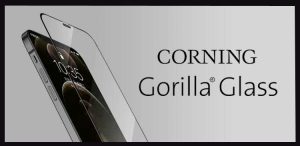

Corning Gorilla Glass:
Corning Incorporated, a renowned American glass and ceramics company, manufactures Corning Gorilla Glass, a specialized type of alkali-aluminosilicate glass. It is thin, lightweight, and highly resistant to damage such as scratches and cracks.
Corning Gorilla Glass features several characteristics that make it highly desirable for use in electronic devices:
- Scratch Resistance: Gorilla Glass is engineered to resist scratches from everyday use, such as keys or coins rubbing against the screen in a pocket or purse.
- Damage Resistance: It offers improved toughness compared to standard glass, making it less prone to breakage from drops or impacts.
- Optical Clarity: Gorilla Glass maintains excellent optical clarity, ensuring that the screen remains clear and vibrant for optimal viewing experience.
- Touch Sensitivity: It retains high touch sensitivity, enabling smooth and responsive interactions with the device’s touchscreen.
- Chemical Resistance: Gorilla Glass is resistant to damage from chemicals such as oils, ensuring that the screen remains easy to clean and free from smudges.
- Environmental Durability:Corning Incorporated designs Gorilla Glass to withstand various environmental factors, including temperature changes and humidity, ensuring reliable performance in different conditions.
Overall, these features combine to make Corning Gorilla Glass a popular choice for covering the displays of a wide range of electronic devices, from smartphones and tablets to laptops and wearable devices.
Corning Gorilla Glass offers several advantages when used in mobile devices:
- Enhanced Durability: Gorilla Glass provides improved resistance to scratches and damage compared to regular glass, prolonging the lifespan of the device’s screen and reducing the need for screen protectors.
- Reduced Breakage : Gorilla Glass enhances toughness, minimizing the risk of the screen shattering or cracking when the device is dropped or subjected to impact, thus providing added peace of mind to users.
- Thinner and Lighter Design: Gorilla Glass allows for thinner and lighter device designs without sacrificing strength or durability, contributing to sleek and portable mobile devices.
- Improved Touch Sensitivity: Despite its durability, Gorilla Glass maintains high touch sensitivity, ensuring smooth and responsive interactions with the touchscreen, which is essential for user experience in mobile devices.
- Optical Clarity: Gorilla Glass maintains excellent optical clarity, providing users with a clear and vibrant display for viewing content on their mobile devices.
- Chemical Resistance: Gorilla Glass is resistant to damage from oils and other chemicals commonly encountered in daily use, making it easier to clean and reducing the likelihood of smudges or stains on the screen.
- Long-Term Reliability: Corning’s rigorous manufacturing processes and quality control standards ensure that Gorilla Glass delivers consistent performance and reliability over time, even with prolonged use.
- Environmentally Resilient:Corning Incorporated designs Gorilla Glass to withstand various environmental factors such as temperature changes and humidity, ensuring that it remains durable and reliable in different conditions.
Overall, these advantages make Corning Gorilla Glass a preferred choice for covering the displays of mobile devices, providing both manufacturers and users with benefits such as improved durability, sleek design, and enhanced user experience.
Each version typically introduces improvements in durability, scratch resistance, and other features. Some of the prominent versions include:
- Gorilla Glass 1: The original version introduced in 2007, providing improved scratch resistance and durability compared to traditional glass.
- Gorilla Glass 2: Introduced in 2012, Gorilla Glass 2 offered the same level of protection as its predecessor but with a thinner profile, enabling sleeker device designs.
- Gorilla Glass 3: Released in 2013, Gorilla Glass 3 featured improved scratch resistance and durability, along with enhanced native damage resistance against deep scratches and cracks.
- Gorilla Glass 4: Introduced in 2014, Gorilla Glass 4 focused on improving drop protection, with Corning claiming it was up to twice as strong as its competitors’ glasses at surviving drops onto rough surfaces.
- Gorilla Glass 5: Released in 2016, Gorilla Glass 5 further enhanced drop performance, with Corning claiming it could survive drops from heights of up to 1.6 meters onto rough surfaces in up to 80% of cases.
- Gorilla Glass 6: Introduced in 2018, Gorilla Glass 6 continued to improve upon drop performance, claiming to withstand multiple drops from greater heights compared to its predecessors.
- Gorilla Glass Victus: Launched in 2020, Gorilla Glass Victus offered significant improvements in drop and scratch resistance compared to previous generations, with Corning claiming it could survive drops from up to 2 meters onto hard, rough surfaces.
